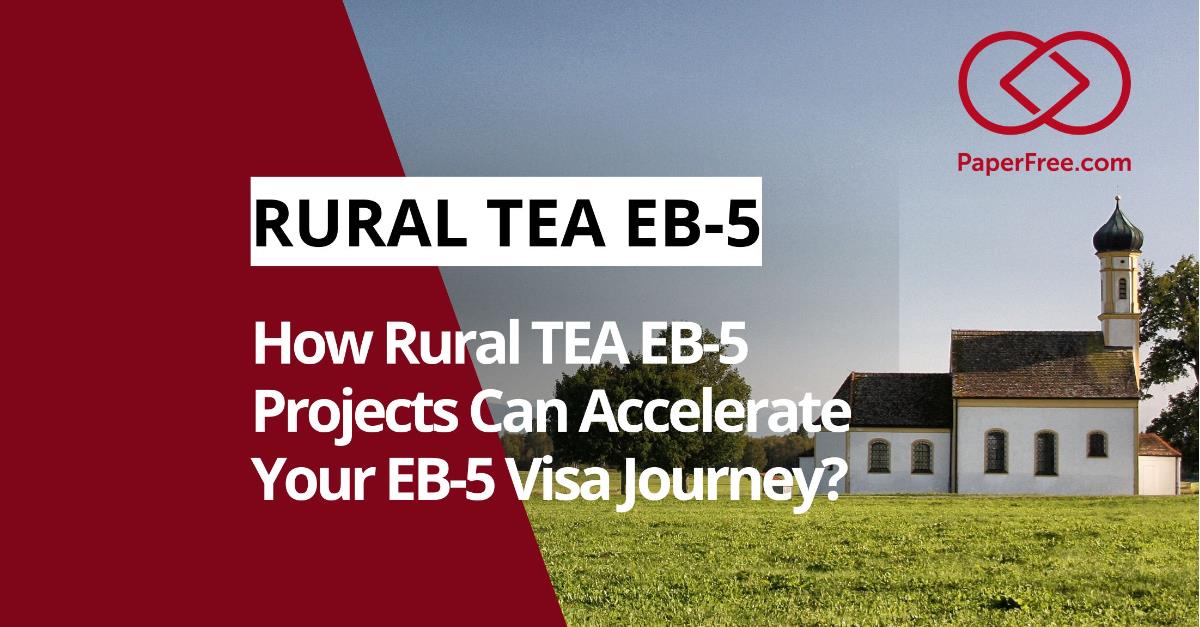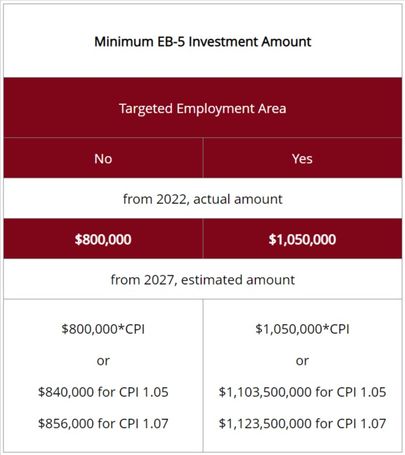EB-5 Visa for Rural Areas for Investors Looking for Speedup Process.
Uncover the perks of Rural TEA EB-5 projects for new investors, offering a straightforward way to attain U.S. permanent residency through lower investment commitments.last updated Monday, October 6, 2025
#EB-5 Visa for Rural Areas #Rural Investment Program
| | by Sidra Jabeen | Content Manager, Paperfree Magazine |

QUICK LINKS
AD
Get Access to EB 5 Investment Visa Resources
Key Points:
- Select an EB-5 project compliant with USCIS standards and backed by a financially robust regional center sponsor.
- Invest a minimum of $800,000 in the chosen project.
- Upon I-526E approval, apply for a two-year conditional Green Card and initiate the immigration process. (For investors already in the U.S., file Form I-485 concurrently with Form I-526E to adjust immigration status.)
- In the final 90 days of the two-year conditional residency, file Form I-829.
- Upon I-829 approval, obtain a permanent U.S. Green Card.
Applying for a Green Card through a Rural TEA project
Acquiring a U.S. Green Card through the EB-5 program typically takes multiple years, but investing in a rural targeted employment area project can expedite the process.
Below, we offer a concise overview of the EB-5 Visa for Rural Areas. Immigration to the United States is frequently a protracted journey, with added complexity for foreign nationals, who often face uncertainty regarding the approval of their petitions, especially if their immigration status depends on sponsorship or a company's financial success.
The EB-5 Immigrant Investor Program stands out among U.S. immigration options for its relative simplicity in achieving lawful permanent resident status. Numerous foreign investors have successfully obtained U.S. Green Cards through EB-5, requiring investments in a new commercial enterprise (NCE) that creates at least 10 jobs per investor and complies with program regulations.
Eligible businesses span various industries such as hospitality, real estate, infrastructure, restaurants, and technology, making EB-5 a versatile investment pathway.
Many investors find it challenging to choose an EB-5 project. A recent regulation offers a potential solution: opting for an EB-5 project in a rural targeted employment area (TEA) can lead to priority processing, significantly expediting the immigration process for visa applicants.
The Benefits of Selecting an EB-5 Visa for Rural Areas
- Reduced Minimum Investment
An EB-5 project's location may qualify as a targeted employment area (TEA) based on United States Citizenship and Immigration Services (USCIS) criteria.
TEA designation is granted to areas with exceptionally high unemployment or rural characteristics, including some public infrastructure projects. Rural TEAs are limited to areas with under 20,000 residents, outside metropolitan statistical areas (MSAs), and not bordering municipalities with populations exceeding 20,000. They require support from the latest U.S. decennial census data.
Whether high-unemployment, rural, or infrastructure-focused, investors in TEA projects are eligible for a reduced investment of $800,000 compared to the standard minimum of $1,050,000.
Learn more about EB5 Investment Amount. - EB5 rural processing time has priority processing
The EB-5 Reform and Integrity Act of 2022 introduced a significant benefit for TEA projects. Signed into law on March 15, 2022, it allocates 32% of EB-5 visas for TEA investments, providing priority processing for investors and their families.
This reserved visa category allows them to expedite the immigration process, essentially allowing them to "skip the line" ahead of other applicants. Of the 32%, 10% are for high-unemployment TEAs, 2% are for public infrastructure TEAs, and 20% are for rural TEAs.
With more reserved visas and historically fewer projects, the latter is expected to facilitate quicker visa processing for investors. USCIS, known for lengthy EB-5 petition processing, may see improvements in processing times, particularly for investors in rural TEA projects.
Valuable Provision for Investors from Backlogged Countries
Investing in rural TEA projects with priority processing is advantageous for investors facing visa retrogression in their home countries.
Visa retrogression occurs when demand exceeds the available supply, affecting countries with many EB-5 investors. In such cases, the Department of State (DOS) assigns a final action date, limiting visas to applicants with I-526 filing dates on or before that date.
Choosing rural TEA projects allows investors to navigate these challenges and receive faster processing.
Final Action Date Delays
Final action dates signify visa availability for investors from backlog-prone countries. While visas are typically obtainable upon I-526 petition approval, applicants facing retrogression can only get Green Cards if their USCIS priority date (I-526 filing date) precedes the Department of State's (DOS) final action date.
For instance, in the May 2022 Visa Bulletin, the DOS set a final action date of November 22, 2015, for Chinese investors in regional center-sponsored EB-5 projects. Investors filing I-526 petitions after this date can't obtain an EB-5 visa, adding complexity due to the slow and unpredictable advancement of final action dates.
Processing Delays
Visa retrogression significantly extends the EB-5 process for affected investors, adding years to the timeline. Before the EB-5 Reform and Integrity Act of 2022, those from backlog-prone countries had limited alternatives within the program.
Now, investors from oversubscribed nations can expedite the process by opting for rural TEAs, which are not subject to retrogression. China, historically the largest market for EB-5, has been in retrogression since 2015, causing substantial delays.
The severity prompted the Department of State to impose a date for filing restriction, potentially delaying Green Card issuance for Chinese investors for a decade or more. Avoiding such delays makes rural EB-5 projects more appealing for investors facing visa retrogression.
Considerations for Investors in Rural EB-5 Projects
While rural EB5 TEA Projects offer enticing priority processing, especially for investors from backlog-prone countries, they come with unique challenges.
Due to low rural populations, these projects, often smaller in scope, may struggle to meet the job creation threshold required for each EB-5 investor. Additionally, reliance on tourism, common in rural projects like hotels, poses risks given the industry's volatility, as seen during the COVID-19 pandemic.
Regardless of the industry, thorough research on project management, regional center sponsors, and capital structure is crucial for confident EB-5 investment decisions.
Rural Job Creation Requirements
Choosing EB5 investment projects, whether in a rural TEA or not, begins with deciding between the program's two investment options:
- The direct investment strategy or
- The EB-5 Rural Regional Center program.
In the direct investment strategy, investors contribute directly to the business without third-party intermediaries, and job creation is limited to full-time positions on the company's payroll.
Conversely, regional centers manage investment capital, providing more flexibility in job creation requirements. Regional center investors can count on indirect and induced Rural Job Creation, easing the creation of 10 new job positions.
Financial and Immigration Risk
Regardless of the chosen investment type, foreign nationals must thoroughly research new commercial enterprises to minimize financial and immigration risks in the EB-5 program.
While financial risk is inherent, investors can mitigate it by scrutinizing project risk factors and opting for projects led by experienced EB5 Rural Regional Center managers.
Immigration risk is crucial, hinging on a project's job creation and capital structure. Examining a project's business plan for substantial job creation potential helps reduce immigration risk. Projects should avoid heavy reliance on EB-5 funding and demonstrate commitment from the developer and external financing, signaling a lower immigration risk for EB-5 investors.
Documentation Requirements
After investing, foreign nationals file Form I-526, providing evidence of the investment in a qualifying project and showcasing legally sourced funds to get an EB-5 Visa for Rural Areas. The petition details the EB-5 project, emphasizing job creation, and must sufficiently prove the project's rural TEA location.
Upon I-526 approval, investors can apply for a two-year temporary Green Card to live and work anywhere in the U.S.
Within this period, Form I-829 is submitted to demonstrate the sustained at-risk investment and the creation of at least ten jobs, leading to the approval of permanent Green Cards.
Rural EB-5 Projects and the Future Potential
Investing in rural EB-5 projects provides an efficient route to U.S. permanent resident status with a reduced minimum investment. Both direct and regional center projects can be situated in rural targeted employment areas (TEAs).
In the coming years, the EB-5 industry anticipates increased popularity of rural TEA projects, contributing to economic growth. Prospective foreign investors can contact Paperfree.com for further information on the EB-5 Rural Investment Program and to discover secure opportunities for rural TEA investments.
For additional assistance in obtaining a U.S. Green Card through a rural EB-5 project, seek guidance to address questions regarding investments in a commercial enterprise, regional centers, United States Citizenship and Immigration Services, and other facets of the EB-5 investment process.
Resources and assistance on each of these steps are available at paperfree.com/en/eb5.
Frequently Asked Questions about EB-5 Visa Rural Projects
1. What is an EB5 Rural Project?
An EB5 Rural Project is an investment opportunity within a rural Targeted Employment Area (TEA) that qualifies for the EB-5 Immigrant Investor Program, offering a path to U.S. residency by investing in economically underdeveloped areas.
2. How do Rural TEA Projects differ from other EB-5 investments?
Rural TEA Projects are located in areas with populations of less than 20,000 outside metropolitan regions. They offer benefits like lower investment thresholds and priority processing compared to urban projects.
3. What are the benefits of investing in Rural EB5 TEA Projects?
Investing in Rural EB5 TEA Projects allows for a reduced minimum investment amount and can expedite visa processing, making it an attractive option for those seeking quicker entry into the U.S.
4. What should I consider before investing in a Rural EB-5 Project?
Before investing in a Rural EB-5 Project, please take a look at its economic viability, the regional center's track record, job creation potential, and the specific requirements of the rural TEA designation.
5. Can you explain the investment process for Rural EB5 Projects?
The investment process involves selecting a qualifying project, ensuring the funds are at risk (meaning actively invested and subject to loss), filing the necessary forms with USCIS, and, ultimately, proving job creation to transition from conditional to permanent resident status.
6. What are the critical steps in obtaining a visa through Rural TEA EB-5 investments?
First, ensure your project qualifies as a Rural TEA and meets the investment criteria. Next, file Form I-526E to demonstrate your investment and eligibility. Upon approval, adjust status or apply for a visa, followed by filing Form I-829 near the end of the two-year conditional period.
7. How long does the EB-5 visa process take for Rural EB5 TEA Projects?
The timeline can vary, but rural projects may receive expedited processing due to fewer applications and prioritization in visa allocations, potentially reducing the overall waiting period.
8. Are there specific risks associated with Rural EB-5 Projects?
Rural EB-5 Projects carry financial risks, including all investments, project failure or insufficient job creation. The rural setting poses additional challenges, such as smaller markets or limited economic activity.
9. How does investing in a Rural EB-5 Project impact my immigration status?
Investing in a Rural EB-5 Project can lead to obtaining a conditional Green Card, followed by permanent residency, upon proving the investment has met all program requirements, including job creation.
10. What documentation is required for investing in a Rural EB5 TEA Project?
You will need to provide financial documentation proving the source of your investment funds, contracts or agreements related to the EB-5 investment, business plans, and evidence supporting the rural location and job creation claims.
Take Away:
Investing in Rural EB-5 Projects offers a unique opportunity for foreign nationals seeking a pathway to U.S. residency through the EB-5 Immigrant Investor Program. With the advantages of reduced minimum investments and priority processing, Rural TEA Projects stand out as a compelling option for those aiming to navigate the complexities of immigration while contributing to the economic development of underserved areas.
Rural EB5 TEA Projects accelerate the visa application process and allow investors to play a pivotal role in stimulating local economies through job creation. By choosing a project in a rural targeted employment area, investors can take advantage of a streamlined process and potentially quicker returns on their financial and immigration investments.
For prospective investors, the decision to invest in an EB5 Rural Project should be made with careful consideration of the project’s viability and compliance with USCIS regulations. It is crucial to conduct thorough research and possibly consult with immigration and financial experts to ensure that your investment meets all the necessary criteria and maximizes your chances of achieving a successful immigration outcome.
Whether you are drawn to the allure of rural America or the benefits of faster processing times, Rural EB-5 Projects provide a path not just to investment returns but also to a new life in the United States. As the demand for these projects grows, understanding the detailed requirements and potential advantages of investing in Rural TEA can make all the difference in your journey to U.S. residency.
For more information and guidance on Rural EB5 TEA Projects, continue exploring our resources or contact our experts. Invest wisely, and take your first step towards securing a future in the U.S. with an EB-5 Rural Investment.
Pages Related to #EB-5 Visa for Rural Areas
- Best EB5 Regional Center List | American EB5 Regional Center

- EB5 Processing Time: A Journey Towards Green Card 2026 | Paperfree.com

- EB-5 Regional Center Program 2027 Expiration: Secure Your Green Card Before Deadline | Renewal Updates

- Rural EB-5 Projects for foreign investor looking for expedited processing.

- US Immigration: No visa backlog under the EB-5 rural category now

- EB 5 projects in New York City

- Copper Valley Rural TEA EB5 Project

- CMB Group 91 Receives I-956F Approval in Record Time: A Milestone for EB-5 Investors

Popular Page
Benefits of the EB-5 Visa Program| A Comprehensive Guide
Book a Free Complimentary Call
real estate investing Investment Visa USA Investment Magazine Private Real Estate Funds real estate funds
